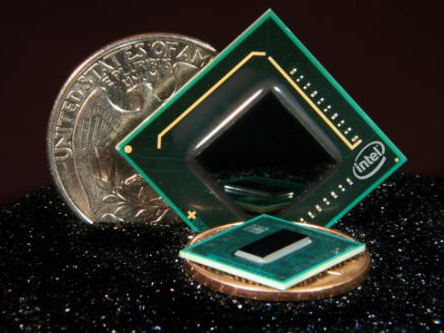Microsoft Pressing Intel for 16-Core Atom
A 16-core Atom in Microsoft's servers could possibly maintain the current level of performance but consume less energy.
Microsoft is reportedly pushing Intel to create a 16-core version of its low-power Atom chip. The reason behind the request makes perfect sense: to use these processors to reduce the overall amount of power consumed by servers stationed in massive data centers--especially those powering Bing, Hotmail and Windows Live Messenger-- without sacrificing performance.
In a speech presented at The Linley Group Data Center Conference in Silicon Valley, Dileep Bhandarkar, an engineer with Microsoft's Global Foundation Services, said that there's a "huge opportunity" to improve energy efficiency by using servers based on processors like Intel's Atom, AMD's Bobcat or Via's Nano.
As it stands now, Intel processors-- like the Xeon--crammed in Microsoft's servers bring high clock speeds but are burdened with heavy power consumption and active cooling, thus costing the company a pretty penny. By using a 16-core Atom processor, Microsoft's thinking is that it can achieve the same high-GHz performance using the low power multi-core chips, thus requiring less power and cooling. Using a system-on-a-chip design would be even better.
"When you look at these tiny cores, another way of making them work in a very efficient way is [not to] surround them with a whole bunch of south bridges and network controllers," he said. "Essentially, the tiny cores and systems-on-chip should go together."
Bhandarkar expects Intel to eventually cave in now that ARM is heading into the server sector, adding that Intel will need to rely on the Atom in order to compete with ARM on power performance per watt. That said, there's a possibility Microsoft could incorporate ARM-based servers in the future. The only drawback is that the architecture will need to overcome a few serious hurdles first while also showing a clear performance benefit over x86 solutions.
"Instruction-set transitions are extremely painful," Bhandarkar said. "As a general rule of thumb, you have to have a sustainable improvement per dollar per watt of at least 2x -- some would say 5x -- but it's at least 2x to make it worthwhile. For some apps where you don't have that dependency the number could be smaller. ARM's an interesting thing to look at and, if nothing else, if it lights a fire under Intel and AMD to deliver more effective x86 solutions, I'm happy."
Currently Intel has no announcements to make in regards to Atom chips for data centers.
Get Tom's Hardware's best news and in-depth reviews, straight to your inbox.

Kevin Parrish has over a decade of experience as a writer, editor, and product tester. His work focused on computer hardware, networking equipment, smartphones, tablets, gaming consoles, and other internet-connected devices. His work has appeared in Tom's Hardware, Tom's Guide, Maximum PC, Digital Trends, Android Authority, How-To Geek, Lifewire, and others.
-
mavroxur A 16 core Atom seems like a neat idea, but the Atom's are lackluster performace-wise. A 16 core Atom against a Xeon LV? That seems like bring a knife to a gunfight.....even though it's a 16-bladed knife.Reply -
stingstang This is like a little kid asking dad for a jetpack, since he flies airplanes. Wants are cool, Microsoft, but realism often takes over after your 10th birthday. How about asking for a 16 core Ivybridge without the graphics core? I'd love to undervolt a sandybridge and compare it to an atom. Toms, take it away.Reply -
jimmysmitty I think MS is asking for the wrong thing. I think what they really want is a Terascale based CPU like the 80 core or 48 core CPu that Intel has shown off. The 80 core, at the time did the same work as 130 CPUs while only using 62w load.Reply
That is what they want because the Terascals is highly customizable unlike Atom. -
oneblackened Why would you use atom? It's a piece of crap processor, easily outclassed by AMD's Zacate Fusion APU (which, as mentioned earlier, is scalable).Reply -
nebun otacon72...yet Microsoft went to intel instead of AMD.intel runs the world, get used to itReply -
alidan mavroxurA 16 core Atom seems like a neat idea, but the Atom's are lackluster performace-wise. A 16 core Atom against a Xeon LV? That seems like bring a knife to a gunfight.....even though it's a 16-bladed knife.correct me if im wrong, but isnt server side of things not dependent on speed but on how much data it can process? the 16 core may = the current ones in data processing power, but would use what is it, 1/5 the power?Reply
jimmysmittyI think MS is asking for the wrong thing. I think what they really want is a Terascale based CPU like the 80 core or 48 core CPu that Intel has shown off. The 80 core, at the time did the same work as 130 CPUs while only using 62w load.That is what they want because the Terascals is highly customizable unlike Atom.
arent those experimental and no where near mass production?
oneblackenedWhy would you use atom? It's a piece of crap processor, easily outclassed by AMD's Zacate Fusion APU (which, as mentioned earlier, is scalable).
because code would need to be rewritten to take advantage of an apu, and that is a massive ammount of work, on par with porting it to arm. -
jprahman Yeah the 48 core terrascale CPU isn't designed to be put into production, it's just for researchers.Reply
Server code can't really run on the GPU part of a APU, at least not web/file server code. The GPU part of a APU can only run massively parallel floating point code, web/file servers don't use much if any floating point math so the APU would be of no help.
I could see a atom with 16 cores doing well in a cloud computing server. A major tenet of cloud computing is to use low power/low cost CPUs in large numbers and so a low power 16 core atom would be a good fit. -
_Pez_ What about Tilera's Processors? those are 100 cores in a die.Reply
http://www.tilera.com/products/processors/TILE-Gx_Family -
jprahman I've heard about those before. They look extremely powerful, although operating systems would have to be adapted and software recompiled.Reply
